Table of Contents:
How to Choose the Right Artist Tools for Beginners?
Strolling down the aisles of your favorite art store or scrolling through all the amazing art supplies online can be especially overwhelming for a beginner artist. The choices seem endless and you’re not sure where to start. That’s the way I felt when I was a newbie. I chose things based on what I thought artists used and not on how the item was actually supposed to be used. After a lot of trial and error, I found the supplies that gave me the results I wanted and I was able to begin a drawing practice that’s helped me take my art to the next level.
To save you the time and money of discovering just what you need, I’ve compiled a list of items I think are essential for the beginner. Think of it as your beginning drawing starter pack. I would like to say that there are as many necessities as there are artists, so what I deem the best art supplies for a beginner may not be what another artist would suggest. But I think that with these supplies, you can get started with confidence and always have the right tool for the right job and that equals success!
What You Need to Get Started

Sketchbook
A sketchbook is probably one of the most important tools an artist has. Drawing regularly is the only way to get better, so it’s important to develop a sketching habit. I have used a lot of different books over the years, but find that this 9”x12” sketchbook is the one I like best.
It’s important to use a sketchbook with pages that are made of a heavier weight paper (68lb/100gsm) than regular printer paper (20lb/75 gsm). Having a thicker paper allows you to draw confidently without fear of your marks making indentions on the next page and gives you the ability to rub and smudge the graphite for shading and blending without the page wrinkling or tearing. I also like a tad larger area to work on, as this gives me plenty of room for making multiple drawings or larger drawings on one sheet.
Another thing to consider when choosing a sketchbook is how it is bound. You can get books that are either glue- or spiral-bound. The glue-bound books look like a traditional book and line up nicely on a bookshelf. Spiral-bound sketchbooks can be flipped open for a flat, sturdy surface.
I also recommend buying sketchbooks in bulk so you always have one on hand. You’ll be surprised that once you start using one on a regular basis you’ll need a new one before you know it.
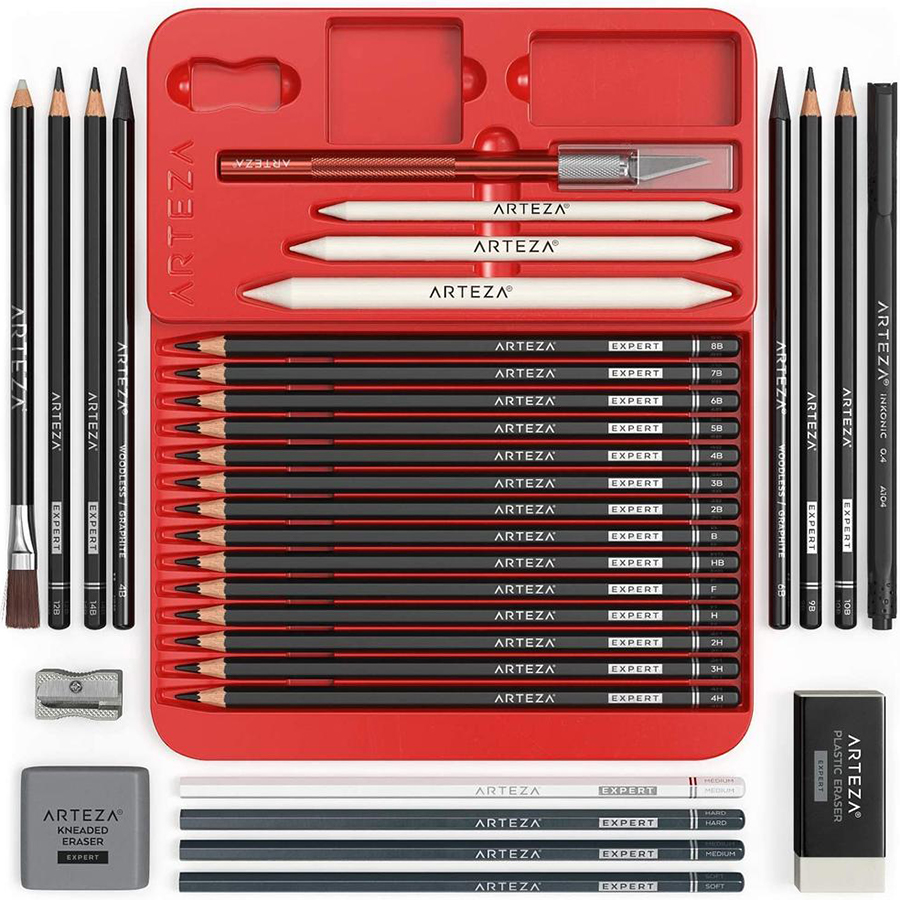
Drawing Pencils
It’s true that you can draw with the classic #2 pencil we all used in school when we were learning how to write. But if you want your drawings to look more realistic or have more nuances like the professional drawings you admire, you’ll want to use professional-grade drawing pencils. These pencils come in varying degrees of lead hardness. Why is that important? Because the harder the lead is, the lighter the mark it makes will be. Conversely, the softer the lead, the darker the mark. Using the right lead makes all the difference when you are developing volume and dimension through shading, or when you want to add fine details to your drawing.
There are plenty of sets out there that include a range of leads. The one I especially like is this 33-piece set from Arteza. Not only do I have 18 pencils that range from a 14B (the softest) to 4H (the hardest) there are also additional pencils, charcoal, erasers, blenders, and sharpeners in the kit. I would recommend this for anyone, beginner or professional, as a quality all-in-one set.
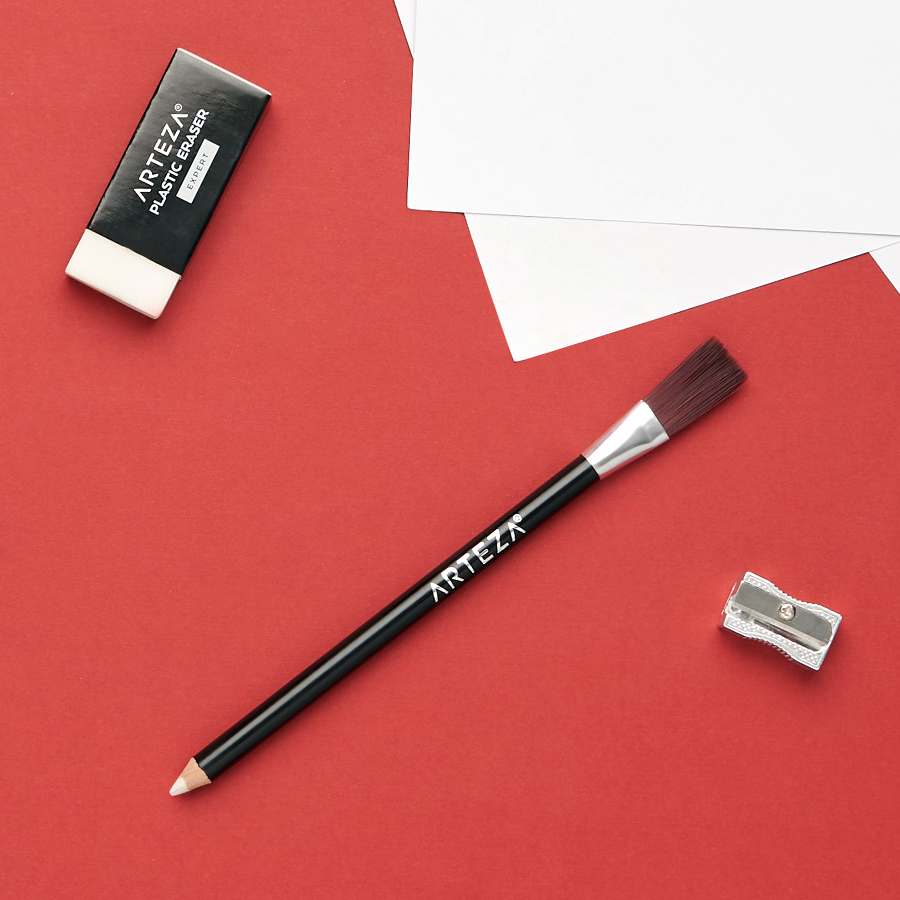
Eraser & Sharpener
An eraser is a versatile tool that artists use for more than just removing unwanted lines. You can use one to create sparkling highlights as well as lighten areas for making subtle shifts in values. There are several different types of erasers to choose from, including rubber, kneaded, plastic, and eraser pencils.
The pink rubber eraser is probably the one you’re most familiar with and is good for removing pencil marks made with medium leads, that’s why you see this eraser on the end of #2 school pencils.
A kneaded eraser is used by artists because it can be shaped into any form, including a point. This makes it perfect for adding those tiny highlights to eyes for example. It also can remove darker marks such as charcoal, without leaving a trace behind.
Plastic erasers are extremely dense and strong erasers that can remove almost anything, including ink.
An eraser pencil is my preferred one. That’s because it combines the strength of a plastic eraser with the controllability of a pencil. I can use a regular pencil sharpener to get a nice point which allows me to “draw” in highlights. One of the best features of this eraser is that it has its own little broom on the end that allows me to sweep away the eraser crumbs and keep my drawing smear-free.
Along with an eraser, a tool every artist must-have is a sharpener. There are plenty of sharpeners on the market from the good old-fashioned manual sharpener to fast-acting electric models. I find that the traditional one is the handiest since it fits in my pencil bag or a pocket. Another good way to keep a point is to use a craft knife to sharpen your pencils.
Luckily Arteza offers a complete drawing set that includes everything you need!
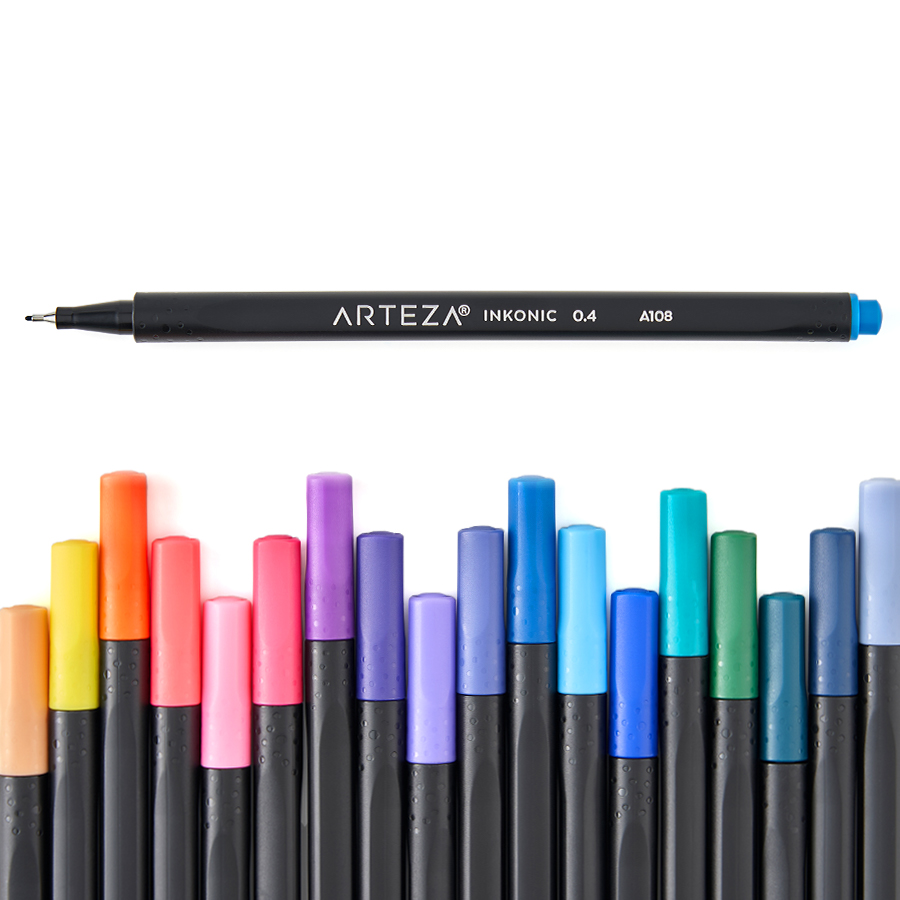
Inkonic Pen
Now that you’ve got your pencils, sketchbook, eraser, and sharpener, it’s time to talk about alternative drawing tools. I love drawing with a fineliner pen. Whether I make the initial drawing in pencil and then go over it in ink or create with ink from start to finish, I find adding it as an element makes for an even more interesting piece.
I like pens that are waterproof and permanent so that if I do choose to color them in, either with a marker or watercolor pencil, the ink won’t smear. I have found that the Arteza Inkonic pens are the most comfortable to use because they have a unique triangular barrel design. This means they won’t roll off my desk either! Plus, they come in a wide variety of colors. There’s also a nice water-based set of black fineliners that I use for when I want to create a drawing and use the ink as a wash to color it in. This set makes it easy to keep pens in my purse, bookbag, in the car, and at home so I’m never looking for one.

Colored Pencils
It’s so much fun to draw with colored pencils. Not only are they great drafting tools, but you get the extra satisfaction of being able to use color to enhance your drawings. By layering your colors, you can build up the intensity of a color or darken it to a shade that will add just the right amount of contrast. It doesn’t take long to get addicted to using them so I suggest you get a set with a lot of colors to start with. My preferred one is this set of 120 artist-grade pencils. These pencils are very dense and full of brilliant pigment. I can’t tell you how much time and money I’ve saved by buying them all at once compared to trying to build a set one or two pencils at a time. Arteza also offers some really cute pencil cases that make it easy (and stylish) to take them to urban sketching meetups, for coffee shop sketching, or to class.

Markers
As you practice more and more, the need to work with color will grow stronger. When I first started out, I found that the quickest way to begin adding color was by using markers. They give me the control of a pen but the flow of ink feels like I’m painting. I always tell beginners to start with dual-tip markers because you get a fine point on one end and a chisel tip on the other. By having these two tips to work with, you’re able to create any width line you want as well as be able to fill small and large areas with a solid color. Here are some great ones to choose from.
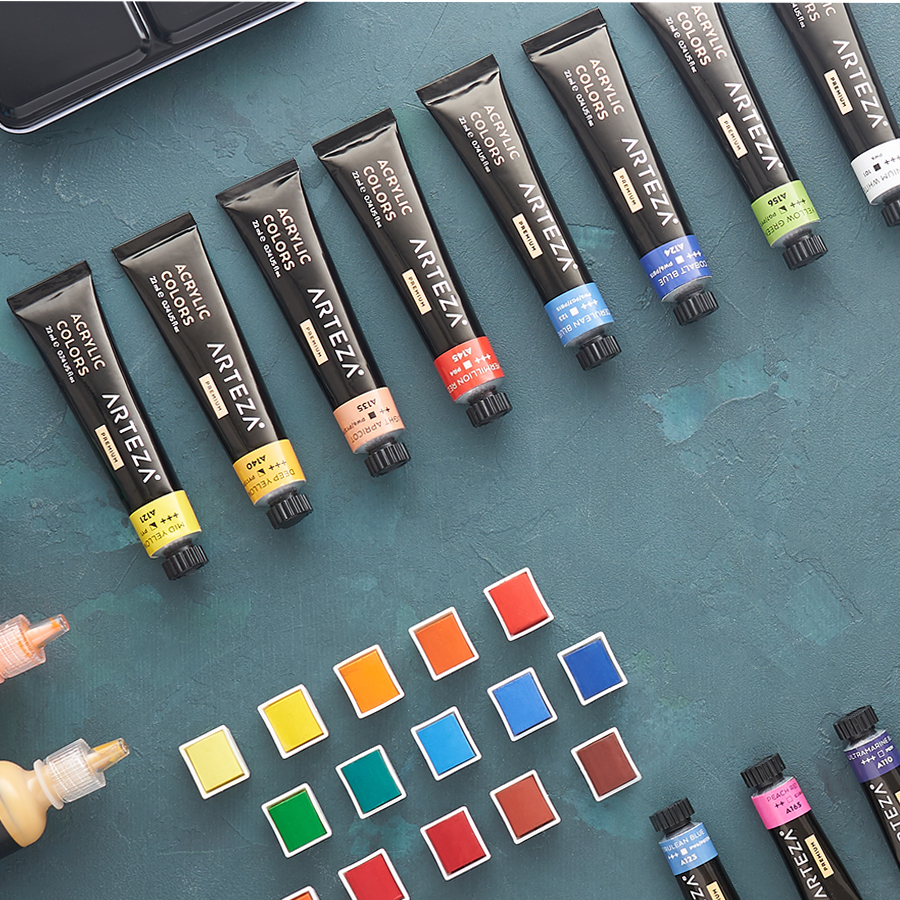
Paints (Acrylic, Watercolor, Gouache)
Once your drafting skills are fine-tuned, painting is the next step. Now, you’re really getting into the swing of being an artist and you’re going to want to try different media to find the one that best suits your style. I suggest starting with prepackaged paint sets at first. Since most sets come with all the basic colors you’ll need, they take the guesswork out of deciding what to buy. It’s also probably best to start with water-based paints, such as acrylics, watercolor, or gouache, as they are easy to mix, clean, and transport, and can be used for a wide range of techniques.
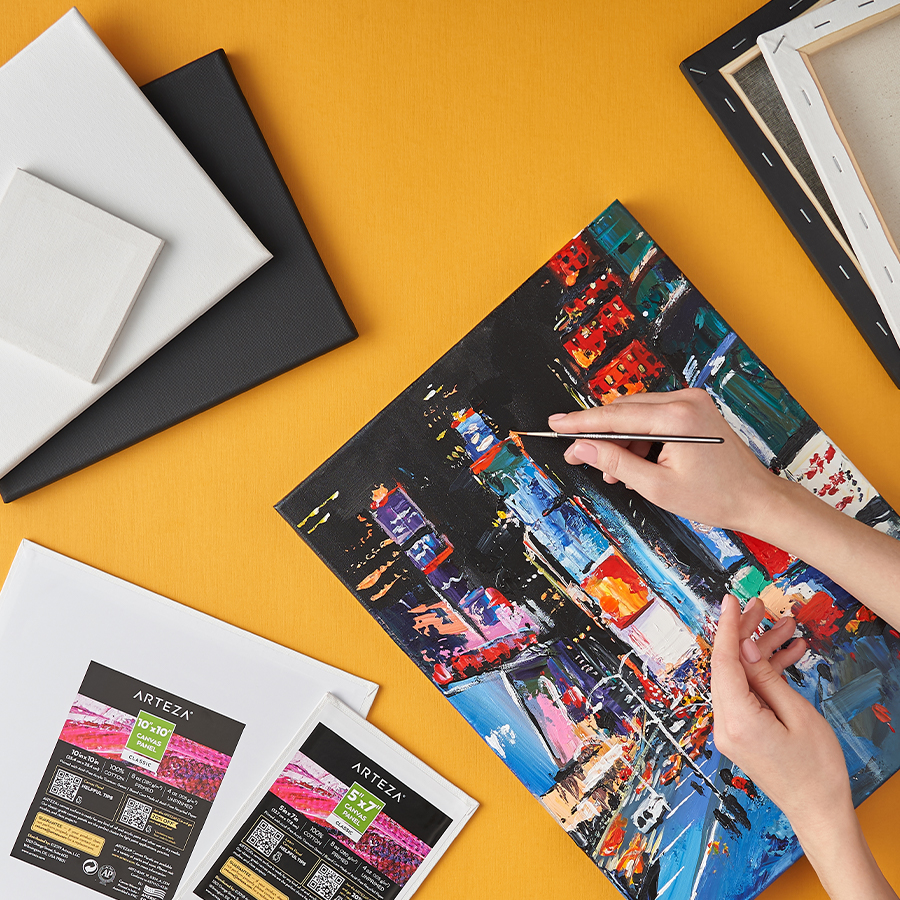
Pad or Canvas
Before you start painting, choosing which surface to paint on will be your next decision. The most important thing to remember when choosing between a pad or a canvas is the media you will use.
Using a watercolor pad has a lot of benefits for water-based painting. It is very convenient to have several sheets bound together. A pad allows you to paint multiple works and keep them securely protected in one place. It is also easy to travel with; just put it in a bag or backpack along with your paints, brushes, and a water cup and you’re ready to go.
On the other hand, painting on canvas gives you a sturdy surface that comes in a range of sizes. You can use an easel or paint on a flat surface.

Brushes
Choosing which brush to use is another place beginning artists get bogged down. I believe it’s best to start with just a few brushes and add ones as you go. The more you paint, the more you will get the feel for what a particular size and shape brush can accomplish. A good place to start is with a liner, a flat, and a round. Here’s the good part: Arteza offers a set of 16 brushes in those types in different sizes, making it the perfect beginner’s kit. And, a good source tells me there are more brushes to come!
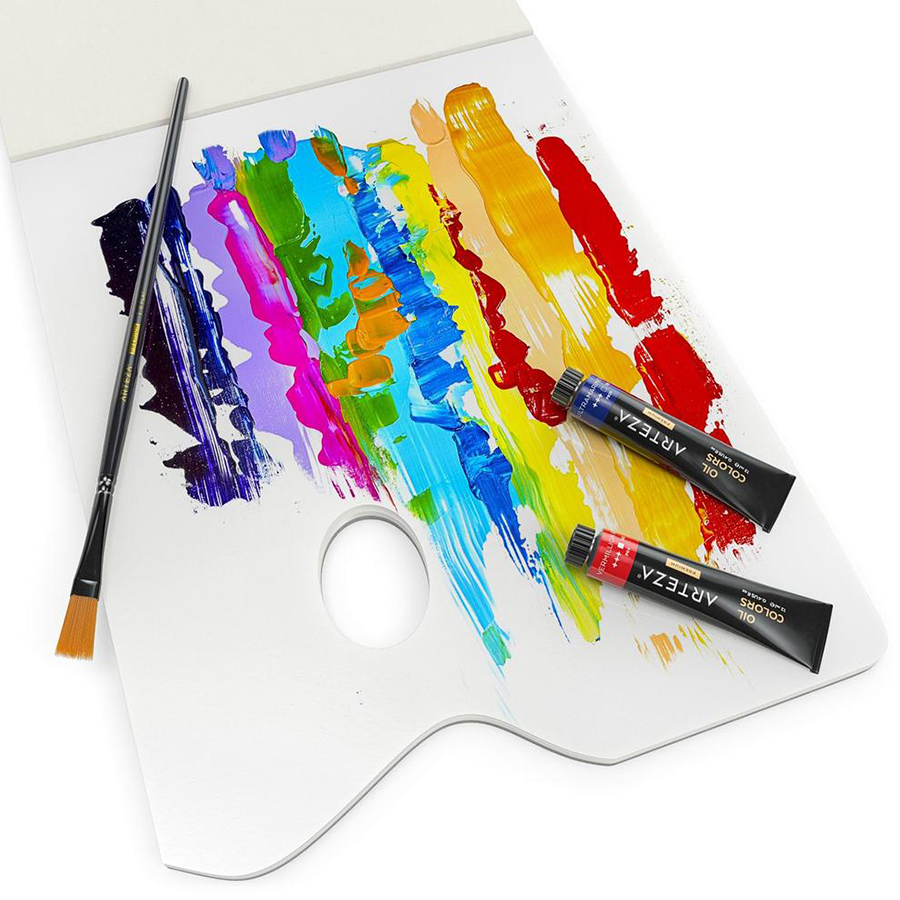
Disposable Palette
So this is one of my top art supply faves—the disposable palette. For years, I worked another job and painted at night after work. Since my time was limited, I really hated having to cut my painting sessions short in order to clean my palette before heading off to bed. When I discovered disposable palettes it was game-changing! I could get a full session in and all I had to do to clean up was rip the palette off the pad and throw it away. My workspace was instantly clean and ready for me to start the next night. I highly recommend these!
There you go! I hope this list has calmed any anxiety you may have been feeling about what art supplies you need. Whether you choose to try them all, just a few, or something different, the important thing is not to wait but to dive in and start drawing and creating! I’d love to hear how your art journey is going and from other artists about what they think beginners need, so please share your thoughts in the comments section.
















